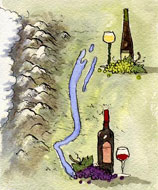
 Over 100 miles long with close to 100 wineries, this is the biggest, oldest and most productive grape-growing region in British Columbia. The Okanagan Valley DVA, with more than 9,000 acres under vine, covers various microclimates, although dry sunny conditions prevail in the lee of the Coastal Range. Most of the Pacific's moisture is filtered from the air by the time it reaches the Valley, but Lake Okanagan provides ample irrigation, while steep slopes intensify the heat. The southern Okanagan, where 70% of the Valley’s wine is produced, is the northern end of the Sonora Desert (the only classified desert in Canada!). Sunny, hot dry summers and less than six inches of annual rainfall provide favorable conditions in the South for reds, notably Pinot Noir, Merlot, Cabernet Sauvignon and Syrah, as well as the principle whites, Pinot Gris and Chardonnay. The North is cooler but still dry, with just 16 inches of annual rainfall. Here, German varieties like Siegerrebe, Sylvaner, Optima and Ortega are more suitable. The dissimilarity from north to south continues in the soils, with glacial stone, silt and clay dominating in the North giving way to sand and gravel in the South. Aside from aridness, the Okanagan Valley DVA is really two regions in one, with such marked differences that further appellation division may be warranted. In fact, to a degree, the cluster of wineries on the east side of the Lake's southern extreme have already begun to identify themselves under the 'unofficial' appellation name Naramata Bench because of the distinct microclimate that exists in their area.
Over 100 miles long with close to 100 wineries, this is the biggest, oldest and most productive grape-growing region in British Columbia. The Okanagan Valley DVA, with more than 9,000 acres under vine, covers various microclimates, although dry sunny conditions prevail in the lee of the Coastal Range. Most of the Pacific's moisture is filtered from the air by the time it reaches the Valley, but Lake Okanagan provides ample irrigation, while steep slopes intensify the heat. The southern Okanagan, where 70% of the Valley’s wine is produced, is the northern end of the Sonora Desert (the only classified desert in Canada!). Sunny, hot dry summers and less than six inches of annual rainfall provide favorable conditions in the South for reds, notably Pinot Noir, Merlot, Cabernet Sauvignon and Syrah, as well as the principle whites, Pinot Gris and Chardonnay. The North is cooler but still dry, with just 16 inches of annual rainfall. Here, German varieties like Siegerrebe, Sylvaner, Optima and Ortega are more suitable. The dissimilarity from north to south continues in the soils, with glacial stone, silt and clay dominating in the North giving way to sand and gravel in the South. Aside from aridness, the Okanagan Valley DVA is really two regions in one, with such marked differences that further appellation division may be warranted. In fact, to a degree, the cluster of wineries on the east side of the Lake's southern extreme have already begun to identify themselves under the 'unofficial' appellation name Naramata Bench because of the distinct microclimate that exists in their area.



 Bi-State Upper Hiwassee Highlands an AVA
Bi-State Upper Hiwassee Highlands an AVA  Michael Bartier is
Michael Bartier is  Gray Monk Estate –
Gray Monk Estate –  Blue Mountain Vineyard Packs ‘Em In
Blue Mountain Vineyard Packs ‘Em In  Quails’ Gate Estate Winery:
Quails’ Gate Estate Winery: The Stereophonic Winemaking Couple
The Stereophonic Winemaking Couple  Remote Manton Valley New California AVA
Remote Manton Valley New California AVA WAWGG Banquet Explores Washington State Terrior
WAWGG Banquet Explores Washington State Terrior Taking Focus on Appellation
Taking Focus on Appellation




